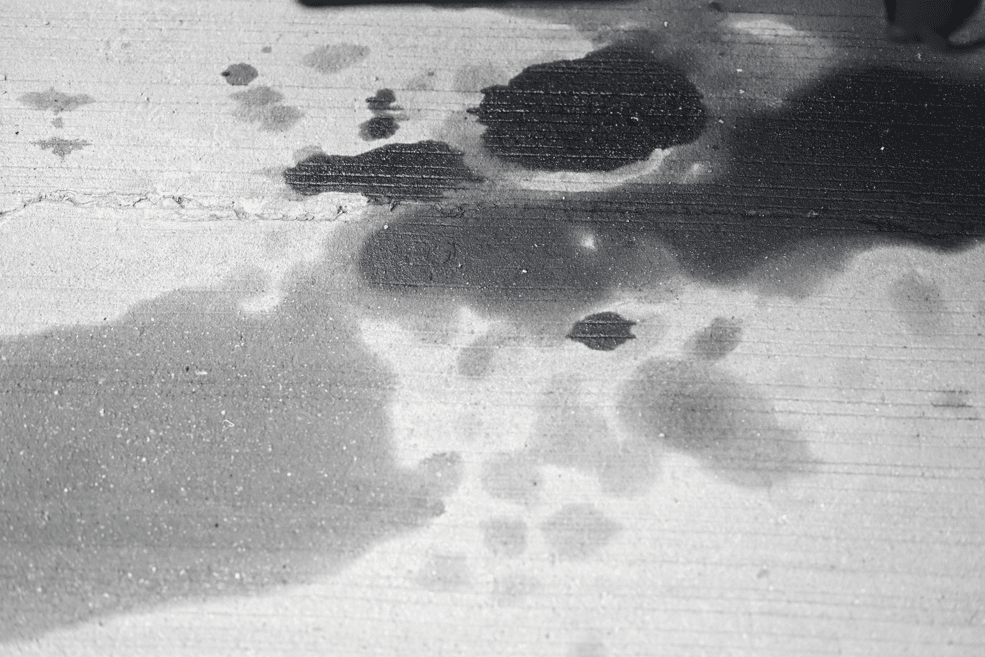Parking lots are high-traffic areas. With that traffic comes the inevitable challenge of oil stains. Cars with small leaks or major oil issues can cause oil to soak into concrete and asphalt, which can quickly deteriorate the pavement. Property managers preparing for restriping often overlook this step, but addressing oil stains before applying fresh paint is essential for long-lasting results.
Why Oil Stains Are More Than Cosmetic
Oil stains may look simply like a cosmetic issue. After all, you’ll find them in every parking lot. However, the impact can go deeper than surface level. Oil and petroleum-based fluids penetrate asphalt, softening the binder that holds aggregate together. Over time, this weakens the pavement, causing crumbling, raveling, and early deterioration.
From a stripping standpoint, untreated oil stains prevent paint from bonding properly to the surface. Paint applied over an oily patch often flakes or fades within weeks, leaving gaps in your markings and reducing both safety and curb appeal.
In short, oil stains are a threat to your pavement structure and your parking lot maintenance budget.
Preparing the Surface: First Steps
Before any remediation can begin, the affected area must be thoroughly cleaned. This usually involves sweeping or blowing away loose debris and dirt. Once the surface is cleared, the stain can be assessed.
Light surface stains may require only a degreasing treatment, while deeper, long-term stains may need more intensive repair. The earlier stains are addressed, the less invasive the remediation process needs to be. This is why routine parking lot maintenance is critical. It’s much easier to clean a small stain today than to replace a crumbling patch tomorrow.
Cleaning and Neutralizing Oil Stains
The most effective way to deal with oil stains is through professional cleaning and neutralization. Contractors typically use industrial-grade degreasers or specialized oil stain removers designed to penetrate the pavement. These products break down the oil and lift it from the pavement, preventing further damage to the asphalt.
Once the stain is treated, the area is scrubbed and rinsed to remove both the leftover oil and the cleaning solution. This step is important because any leftover residue from the oil or cleaning solution can interfere with the striping paint adhesion. The goal is a clean, neutral surface that paint can grip securely.
When Surface Cleaning Isn’t Enough
Some oil stains are so severe that cleaning alone cannot restore the surface. In these cases, additional repair methods may be necessary. This can include applying an oil spot primer, which is an adhesive treatment designed to seal in stubborn stains and create a paintable surface.
In extreme situations where oil has deeply penetrated the asphalt, removing and patching the affected area may be the only effective long-term solution. While more costly, these repairs prevent ongoing deterioration and ensure the lot remains safe and functional.
Timing Oil Remediation With New Markings
For the best results, oil stain remediation should always happen before restriping. Fresh paint relies on a clean, even surface to bond properly, and untreated stains will cause premature fading. Try to schedule oil stain removal a few days before restriping to reduce the likelihood of new oil stains developing.
Property managers should build this step into their maintenance schedule, ideally combining it with other preventative services like crack filling and sealcoating. Addressing oil stains early not only improves the appearance of your lot but also saves time and money by preventing paint failures that require frequent touch-ups.
The Cost of Skipping Remediation
Skipping oil stain remediation can seem like a time-saver, but it often leads to higher costs down the road. Paint that doesn’t adhere properly must be reapplied, sometimes within weeks of a project. Beyond appearance, oil-weakened pavement is more likely to crack, crumble, and develop potholes, leading to expensive repairs or replacement.
For property managers, this creates an avoidable cycle of repainting and patching. Investing in remediation upfront protects both the asphalt and the striping, extending the lifespan of your maintenance efforts.
Partnering With Experienced Contractors
Remediation requires more than just a quick scrub. It takes the right products, tools, and experience to properly clean and neutralize oil stains so that striping paint can last. Professional contractors know how to evaluate each stain, determine the best treatment, and apply the right primers or repairs when necessary.
Oil stains may be a common sight in parking lots, but they should never be ignored, especially before new markings are applied. By taking the time to clean, neutralize, and, when necessary, repair stained areas, property managers can protect their pavement, improve curb appeal, and ensure that fresh lines remain crisp and durable.
At Otto’s Parking Marking, we specialize in preparing lots for long-lasting results. Our team addresses oil stains, fills cracks, applies sealcoats, and restripes, all in the correct order and with the right timing. This comprehensive approach ensures every project we complete looks great and holds up for years to come.
Let Otto’s Parking Marking Help You!
Ready to prepare your lot for bright, long-lasting markings? Otto’s Parking Marking has the expertise and equipment to remediate oil stains and deliver professional striping that lasts. Contact our team today to schedule your next maintenance project and keep your property looking its best.

